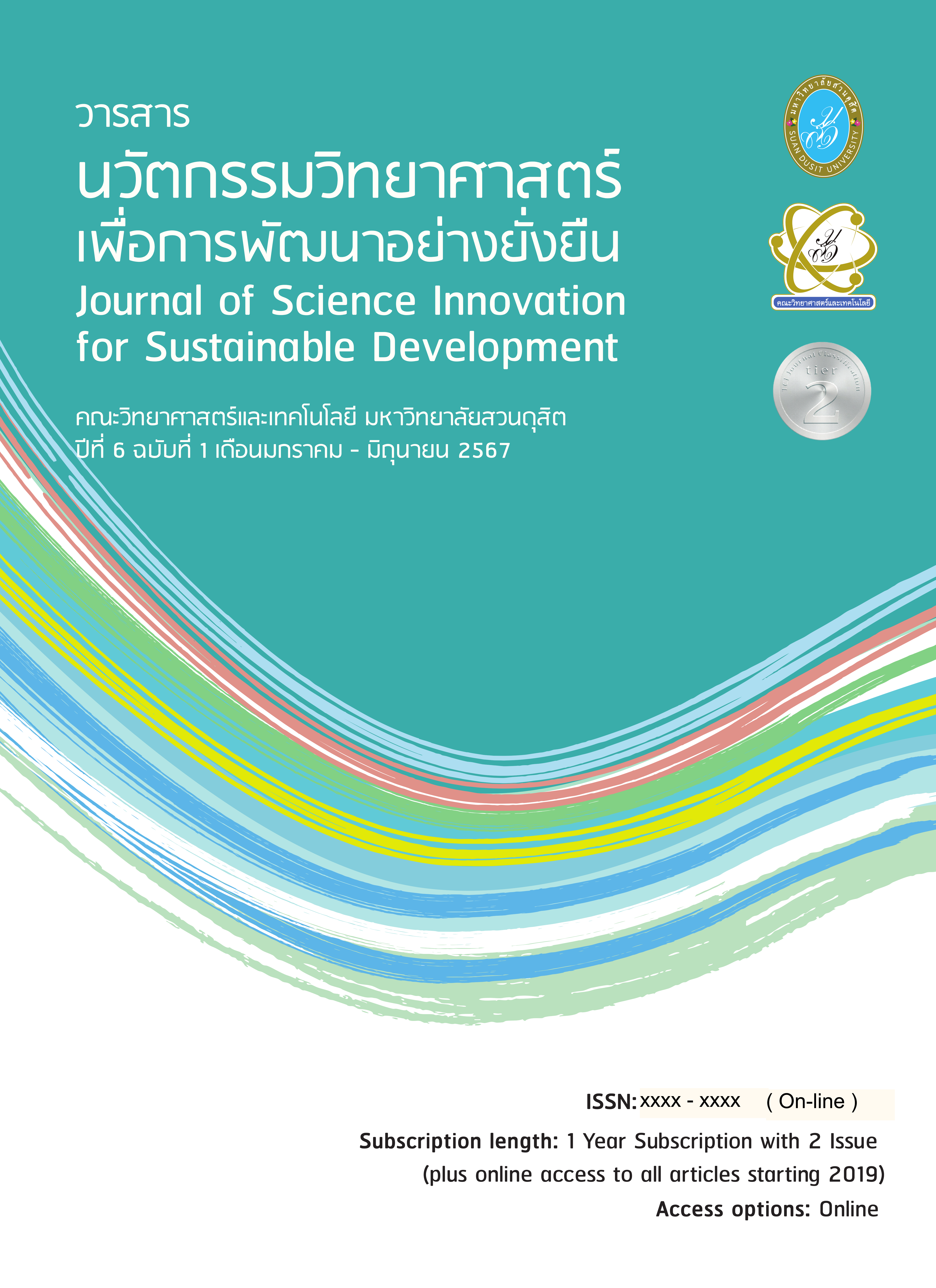Evaluations of Effectiveness for Beverage Packaging Waste Sorting Using Huskylens Based on AI Machine Vision Suttipong Klongdee1 Songwut Boonsong2 Karin Kosiyanurak3 and Sommart Promput*,4
Main Article Content
บทคัดย่อ
Waste is a significant issue of which people worldwide should be aware, and excessive waste in Thailand continues to persist. This leads to environmental challenges. Thailand produces 27–28 million tons of solid waste per year. Therefore, waste separation is an important factor in mitigating these problems. Beverage packaging waste management has the opportunity to greatly reduce pollution in the environment. This research has developed a waste sorting machine that uses IoT technology, consisting of an Arduino Uno WiFi, Huskeylens, and other devices. The beverage packaging waste was categorized into three distinct groups: plastic bottles, glass bottles, and cans. There are a total of 30 samples. The findings demonstrate that the garbage sorter has the capacity to precisely identify the dataset. The Line application can efficiently and precisely inform consumers about the status of garbage pickup. The system's optimal operational distance is 30 cm, ensuring maximum efficiency between the Huskylens and the object at a luminance level of 305 lux. Furthermore, it can aid in the efficient categorization of recyclable waste and promote the reduction of environmental pollution. Furthermore, it can facilitate the effective classification of recyclable garbage and encourage the reduction of environmental contamination.
Article Details

อนุญาตภายใต้เงื่อนไข Creative Commons Attribution-NonCommercial-NoDerivatives 4.0 International License.
ลิขสิทธิ์ต้นฉบับที่ได้รับการตีพิมพ์ในวารสารนวัตกรรมวิทยาศาสตร์เพื่อการพัฒนาอย่างยั่งยืนถือเป็นกรรมสิทธิ์ของคณะวิทยาศาสตร์และเทคโนโลยี มหาวิทยาลัยสวนดุสิต ห้ามผู้ใดนำข้อความทั้งหมดหรือบางส่วนไปพิมพ์ซ้ำ เว้นแต่จะได้รับอนุญาตอย่างเป็นลายลักษณ์อักษรจากคณะวิทยาศาสตร์และเทคโนโลยี มหาวิทยาลัยสวนดุสิต นอกจากนี้ เนื้อหาที่ปรากฎในบทความเป็นความรับผิดชอบของผู้เขียน ทั้งนี้ไม่รวมความผิดพลาดอันเกิดจากเทคนิคการพิมพ์
เอกสารอ้างอิง
Alcaraz-Londoño, L. M., Ortiz-Clavijo, L. F., Duque, C. J. G., & Betancur, S. A. G. (2022). Review on techniques of automatic solid waste separation in domestic applications. Bulletin of Electrical Engineering and Informatics, 11(1), 128-133.
Bouchabou, D., Nguyen, S. M., Lohr, C., LeDuc, B., & Kanellos, I. (2021). A survey of human activity recognition in smart homes based on IoT sensors algorithms: Taxonomies, challenges, and opportunities with deep learning. Sensors, 21(18), 6037.
Boukabous, M., & Azizi, M. (2023). Image and video-based crime prediction using object detection and deep learning. Bulletin of Electrical Engineering and Informatics, 12(3), 1630-1638.
Chen, S., Tan, S., Li, B., & Huang, J. (2015). Automatic detection of object-based forgery in advanced video. IEEE Transactions on Circuits and Systems for Video Technology, 26(11), 2138-2151.
Davenport, T., & Kalakota, R. (2019). The potential for artificial intelligence in healthcare. Future healthcare journal, 6(2), 94.
Fritsch, J., Lang, S., Kleinehagenbrock, A., Fink, G. A., & Sagerer, G. (2002, September). Improving adaptive skin color segmentation by incorporating results from face detection. In Proceedings. 11th IEEE International Workshop on Robot and Human Interactive Communication (pp. 337-343). IEEE.
Ghobaei‐Arani, M., Rahmanian, A. A., Souri, A., & Rahmani, A. M. (2018). A moth‐flame optimization algorithm for web service composition in cloud computing: simulation and verification. Software: Practice and Experience, 48(10), 1865-1892.
Hasan, M. K., Khan, M. A., Issa, G. F., Atta, A., Akram, A. S., & Hassan, M. (2022, February). Smart waste management and classification system for smart cities using deep learning. In 2022 International Conference on Business Analytics for Technology and Security (ICBATS) (pp. 1-7). IEEE.
Jones, A., Ramya, B., Sreedharani, M. P., Yuvashree, R. M., & Jacob, J. (2023, June). Tyro: A Mobile Inventory Pod for e-Commerce Services Check for updates. In Proceedings of International Conference on Computational Intelligence and Data Engineering: ICCIDE 2022 (Vol. 163, p. 401). Springer Nature.
Kahdim, A. N., & Manaa, M. E. (2022). Design an efficient internet of things data compression for healthcare applications. Bulletin of Electrical Engineering and Informatics, 11(3), 1678-1686.
Kennedy-Metz, L. R., Mascagni, P., Torralba, A., Dias, R. D., Perona, P., Shah, J. A., ... & Zenati, M. A. (2020). Computer vision in the operating room: Opportunities and caveats. IEEE transactions on medical robotics and bionics, 3(1), 2-10.
Laghari, A. A., Wu, K., Laghari, R. A., Ali, M., & Khan, A. A. (2021). A review and state of art of Internet of Things (IoT). Archives of Computational Methods in Engineering, 1-19.
Miko, P., Shiela, M. M., Hilary, R., & Mary, J. S. (2019). i-BIN: An Intelligent Trash Bin for Automatic Waste Segregation and Monitoring System. In Proceedings of the 2019 IEEE 11th International Conference on Humanoid, Nanotechnology, Information Technology, Communication and Control, Environment, and Management (HNICEM), Laoag, Philippines (Vol. 29).
Molina, R. A., & Catan, I. (2021). Solid waste management awareness and practices among senior high school students in a state college in Zamboanga City, Philippines. Aquademia, 5(1), ep21001.
Pollution Control Department, "Report on the situation of solid waste in the country," 2022, https://www.pcd.go.th/wp-content/uploads/2023/04/pcdnew-2023-05-23_07-53-42_299799.pdf
Pongpunpurt, P., Muensitthiroj, P., Pinitjitsamut, P., Chuenchum, P., Painmanakul, P., Chawaloesphonsiya, N., & Poyai, T. (2022). Studying waste separation behaviors and environmental impacts toward sustainable solid waste management: A case study of Bang Chalong Housing, Samut Prakan, Thailand. Sustainability, 14(9), 5040.
Promput, S., Maithomklang, S., & Panya-isara, C. (2023). Design and Analysis Performance of IoT-Based Water Quality Monitoring System using LoRa Technology. TEM Journal, 12(1).
Siddiqua, A., Hahladakis, J. N., & Al-Attiya, W. A. K. (2022). An overview of the environmental pollution and health effects associated with waste landfilling and open dumping. Environmental Science and Pollution Research, 29(39), 58514-58536.
Sirawattananon, C., Muangnak, N., & Pukdee, W. (2021, May). Designing of IoT-based smart waste sorting system with image-based deep learning applications. In 2021 18th International Conference on Electrical Engineering/Electronics, Computer, Telecommunications and Information Technology (ECTI-CON) (pp. 383-387). IEEE.
Siswoyo, A., & Indrawan, R. W. (2023). Development Of an Autonomous Robot To Guide Visitors In Health Facilities Using A Heskylens Camera: Development Of an Autonomous Robot To Guide Visitors In Health Facilities Using A Heskylens Camera. J-Innovation, 12(1), 12-19.
Sudha, S., Vidhyalakshmi, M., Pavithra, K., Sangeetha, K., & Swaathi, V. (2016, July). An automatic classification method for environment: Friendly waste segregation using deep learning. In 2016 ieee technological innovations in ict for agriculture and rural development (tiar) (pp. 65-70). IEEE.
Yadav, S., Shanmugam, A., Hima, V., & Suresh, N. (2021, April). Waste classification and segregation: Machine learning and iot approach. In 2021 2nd international conference on intelligent engineering and management (ICIEM) (pp. 233-238). IEEE.


